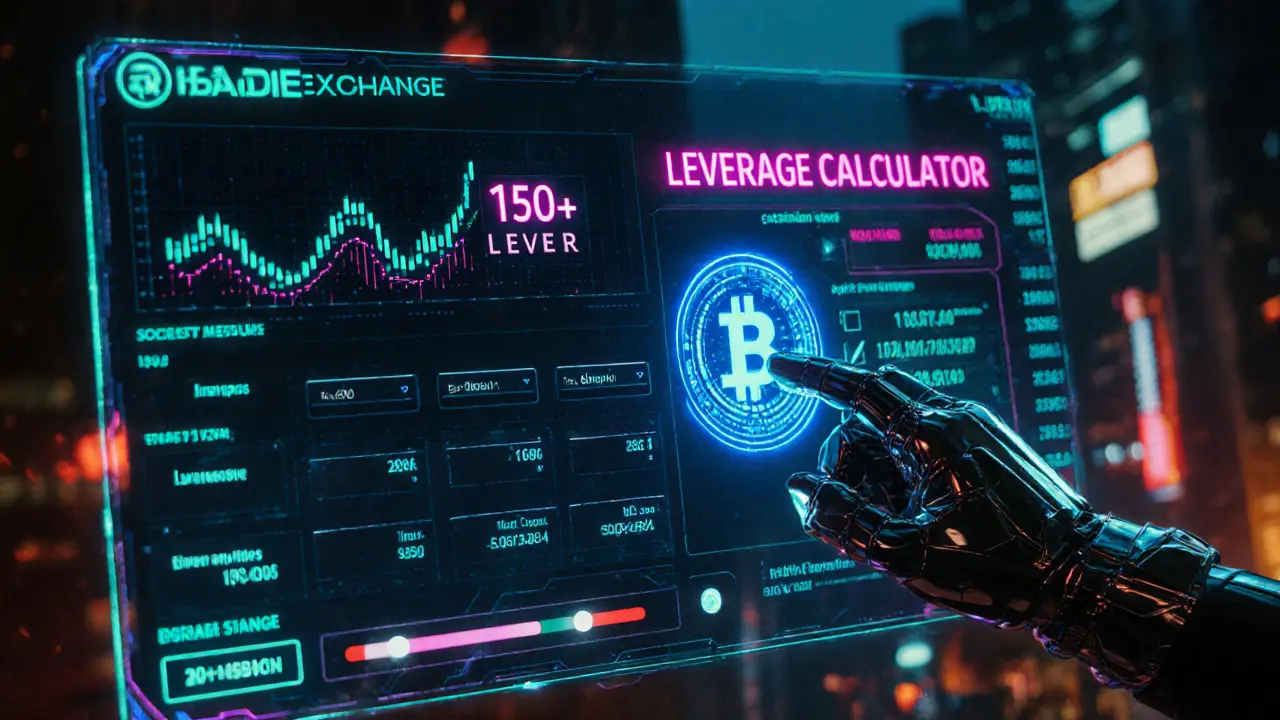Blade Exchange Leverage Calculator
Use this calculator to estimate potential profits and losses with Blade Exchange's high leverage perpetual swaps. Enter your position size, leverage level, and price movement to see how much you could gain or lose.
Potential Outcome
Position Size: $1,000
Price Movement: +1%
Total Exposure: $150,000
Potential Gain/Loss: $150
New Position Value: $1,150
About Blade Exchange
Blade Exchange offers perpetual swap contracts with up to 150× leverage on BTC-USD and BTC-KRW, settling in USDT. This calculator demonstrates the extreme risk-reward profile of high-leverage trading.
Quick Takeaways
- Blade offers perpetual swap contracts with up to 150x leverage on BTC‑USD and BTC‑KRW.
- All contracts are margined and settled in USDT, keeping settlement stable.
- Founded by Jeff Byun and Henry Lee, veterans of OrderAhead and Square.
- Regional restrictions mean the platform is unavailable in many jurisdictions.
- Compared with Coinbase and Binance, Blade focuses on simple vanilla contracts and higher leverage.
What is Blade?
When it comes to crypto derivatives, Blade is a cryptocurrency derivatives exchange that launched in August 2019, targeting traders who want to speculate on price moves without owning the underlying asset. The platform’s niche is perpetual swap contracts - a type of futures contract that never expires, allowing traders to stay long or short indefinitely.
Who built Blade and why it matters
The brain‑trust behind Blade includes Jeff Byun, a former co‑founder of OrderAhead, the on‑demand delivery startup that Square partially acquired in 2017. His partner, Henry Lee, also helped launch OrderAhead and has a background in finance engineering at Morgan Stanley. Their experience straddles both tech startups and traditional trading, which explains Blade’s ambition to build a "foundational layer" for crypto markets.
Blade’s seed round raised $4.3million from heavy‑hitters like Coinbase, the leading US crypto exchange and early investor in Blade, as well as venture firms SVAngel, A.Capital, Slow Ventures, and individual backers such as Justin Kan and Adam D’Angelo.
Core product: Perpetual swap contracts
A perpetual swap works like a regular futures contract, except there’s no set expiration date. Blade’s contracts are “vanilla” - meaning they stick to the basics: you pick a pair (e.g., BTC‑USD), choose your leverage, and the platform automatically funds the funding rate to keep the contract price in line with the spot market.
Leverage on Blade tops out at 150× for the BTC‑USD and BTC‑KRW pairs. That means a $1,000 margin could control $150,000 worth of Bitcoin exposure. The high‑leverage offering is a double‑edged sword: it can amplify gains, but a 0.66% move against you wipes out the entire position.

How the platform works: Settlement in USDT
Every contract on Blade is margined and settled in USDT (Tether), the stablecoin pegged to the US dollar. Using USDT simplifies margin calls because traders don’t need to convert from other tokens during a volatile swing. The settlement process automatically credits or debits your USDT balance based on the contract’s P&L.
Strengths and weaknesses
- High leverage: 150× is among the most aggressive limits in the market, appealing to aggressive day traders.
- Simplified contracts: vanilla perpetuals lower the learning curve compared with more exotic options or binary futures.
- Fast execution: users on G2 praise the platform’s speed and responsive UI.
- Regional restrictions: legal hurdles keep Blade out of the US, EU, and several Asian markets.
- Limited public data: few third‑party ratings make it hard to gauge long‑term reliability.
Blade vs the big players
| Feature | Blade | Coinbase Pro | Binance Futures |
|---|---|---|---|
| Leverage limit | 150× (BTC‑USD, BTC‑KRW) | 5× (selected pairs) | 125× (multiple pairs) |
| Contract type | Vanilla perpetual swaps | Standard futures (expiring) | Perpetual swaps & futures |
| Margin settlement | USDT | USD, USDC | USDT, BUSD |
| Regional availability | Limited (mostly Asia) | US, EU, Canada | Global (subject to local law) |
| Investor backing | Coinbase, SVAngel, A.Capital | Publicly listed, VC‑backed | Binance Group, multiple VCs |
Who can actually use Blade?
The platform is built for experienced traders who already understand leverage, margin calls, and the risks of perpetual swaps. Beginners may find the 150× leverage intimidating, especially without a solid risk‑management plan.
Feedback collected by G2 highlights two recurring themes: the UI feels clean and trade execution is lightning‑fast, but the service “isn't supported in many regions”. Users in South Korea and Hong Kong report smooth onboarding, whereas traders in the United States, Canada, and most of Europe receive a “service not available” notice, likely due to regulatory constraints.
Because Blade settles in USDT, anyone who already holds Tether can fund the account instantly. If you’re new to USDT, you’ll need to acquire the stablecoin on a separate exchange before you can trade on Blade.
Bottom line
If you’re looking for a platform that strips down derivatives to the essentials-high leverage, vanilla perpetuals, and USDT settlement-then Blade exchange ticks the right boxes. Its backers (including Coinbase) and the founders’ tech‑trading pedigree lend credibility, but the heavy regional restrictions and lack of independent audit reports keep the user base relatively niche. For seasoned traders comfortable with 150× exposure and who reside in supported jurisdictions, Blade offers a fast, focused experience. For everyone else, more established exchanges like Coinbase Pro or Binance Futures may feel safer.

Frequently Asked Questions
What assets can I trade on Blade?
Blade currently offers perpetual swaps for Bitcoin against USD (BTC‑USD) and South Korean Won (BTC‑KRW), plus a handful of altcoins such as Monero, Dogecoin, Zcash, Ripple, and Binance Coin, all settled in USDT.
How does Blade handle funding rates?
Funding rates are calculated every eight hours and automatically transferred between long and short positions to keep the perpetual price aligned with the spot index. Positive rates mean longs pay shorts; negative rates flip the flow.
Is Blade regulated?
Blade does not hold a full broker‑dealer license in the United States or the European Union. It operates under a limited‑license framework that allows it to serve jurisdictions where crypto‑derivatives are not explicitly prohibited.
Can I use a credit card to fund my Blade account?
Funding is limited to crypto deposits, primarily USDT. Blade does not support fiat on‑ramps such as credit‑card or bank transfers at this time.
What safety measures does Blade provide for high‑leverage trading?
Blade employs automatic liquidation thresholds, real‑time margin monitoring, and a built‑in insurance fund that absorbs excess losses when a user’s position is liquidated beyond their margin.


Jacob Anderson
January 22, 2025 AT 05:57Oh great, another exchange that thinks 150× leverage is a smart idea. Because nothing says “responsible trading” like letting a 0.66% move wipe you out instantly.
VICKIE MALBRUE
January 23, 2025 AT 04:13Sounds risky but exciting good luck
Katrinka Scribner
January 24, 2025 AT 03:16I love the idea of high‑leverage but wow 😬 that 0.66% liquidation level is scary 😱 hope you have good risk tools 🙏
april harper
January 25, 2025 AT 02:20In the grand tapestry of finance, Blade attempts to stitch a thread of pure leverage, yet the fabric may fray under the slightest gust of market wind.
Kate Nicholls
January 26, 2025 AT 01:23The platform’s focus on vanilla perpetuals does simplify things, but the lack of regional availability and limited transparency are hard to ignore.
Waynne Kilian
January 27, 2025 AT 00:26i think its nice that they use usdt for settlement, it makes margin calls simplier but the supsension in many countris is a real drawback.
Michael Wilkinson
January 27, 2025 AT 23:30Don’t trade there unless you enjoy watching your account evaporate.
Billy Krzemien
January 28, 2025 AT 22:33If you decide to experiment with high leverage, start with a tiny position, set stop‑losses, and continuously monitor the funding rate to avoid surprise liquidations.
Clint Barnett
January 29, 2025 AT 21:36Blade Exchange certainly grabs attention with its 150× leverage ceiling.
That number alone can make seasoned traders salivate and novices tremble.
The platform’s UI is clean, which helps users navigate the calculator without getting lost in menus.
Settling everything in USDT removes the need for constant currency conversion, a boon for those who already hold stablecoins.
However, the risk–reward profile is skewed heavily toward risk; a 0.66% adverse move can wipe out an entire position, which is unforgiving even for experienced traders.
The funding rate mechanism, recalculated every eight hours, adds another layer of cost that can erode profits over time.
Because Blade is largely unavailable in the US, EU, and many Asian jurisdictions, its user base remains niche and possibly more homogeneous.
The backing from Coinbase and notable VCs lends credibility, yet the paucity of third‑party audits leaves some questions unanswered.
Compared to Binance Futures’ 125× leverage, Blade pushes the envelope further, but the trade‑off is less diversified product offerings.
For traders who thrive on rapid execution and are comfortable managing tight stop‑losses, Blade could be a valuable addition to their toolbox.
Conversely, those who prefer a broader range of assets or more regulated environments might find better alternatives.
The platform’s insurance fund, designed to absorb excess losses, is a safety net in theory but lacks public reporting.
In practice, using the built‑in calculator before committing capital is a wise habit that many ignore.
Ultimately, Blade is a high‑octane engine: it will deliver speed and leverage, but without disciplined risk management, it will also consume its driver.
Approach it with caution, respect the leverage, and remember that in crypto derivatives, the line between profit and liquidation can be razor‑thin.
Ben Dwyer
January 30, 2025 AT 20:40Great breakdown, just remember to keep your position size small until you’re comfortable with the mechanics.
Rajini N
January 31, 2025 AT 19:43For newcomers, I suggest testing the platform with a demo account if available, and always calculate potential exposure before pulling the trigger.
Kate Roberge
February 1, 2025 AT 18:46sure, the settlement in usdt is cute but who cares when you can’t even access the exchange in most countries.
Oreoluwa Towoju
February 2, 2025 AT 17:50Leverage is a double‑edged sword.
Amie Wilensky
February 3, 2025 AT 16:53Wow!!!; this platform-nay, this beast-offers 150× leverage; is that not just an invitation to chaos???
Charles Banks Jr.
February 4, 2025 AT 15:56Because nothing says “responsible investing” like handing traders a hundred‑plus times leverage on a volatile asset.
Lindsay Miller
February 5, 2025 AT 15:00Stay safe and always trade within what you can afford to lose.